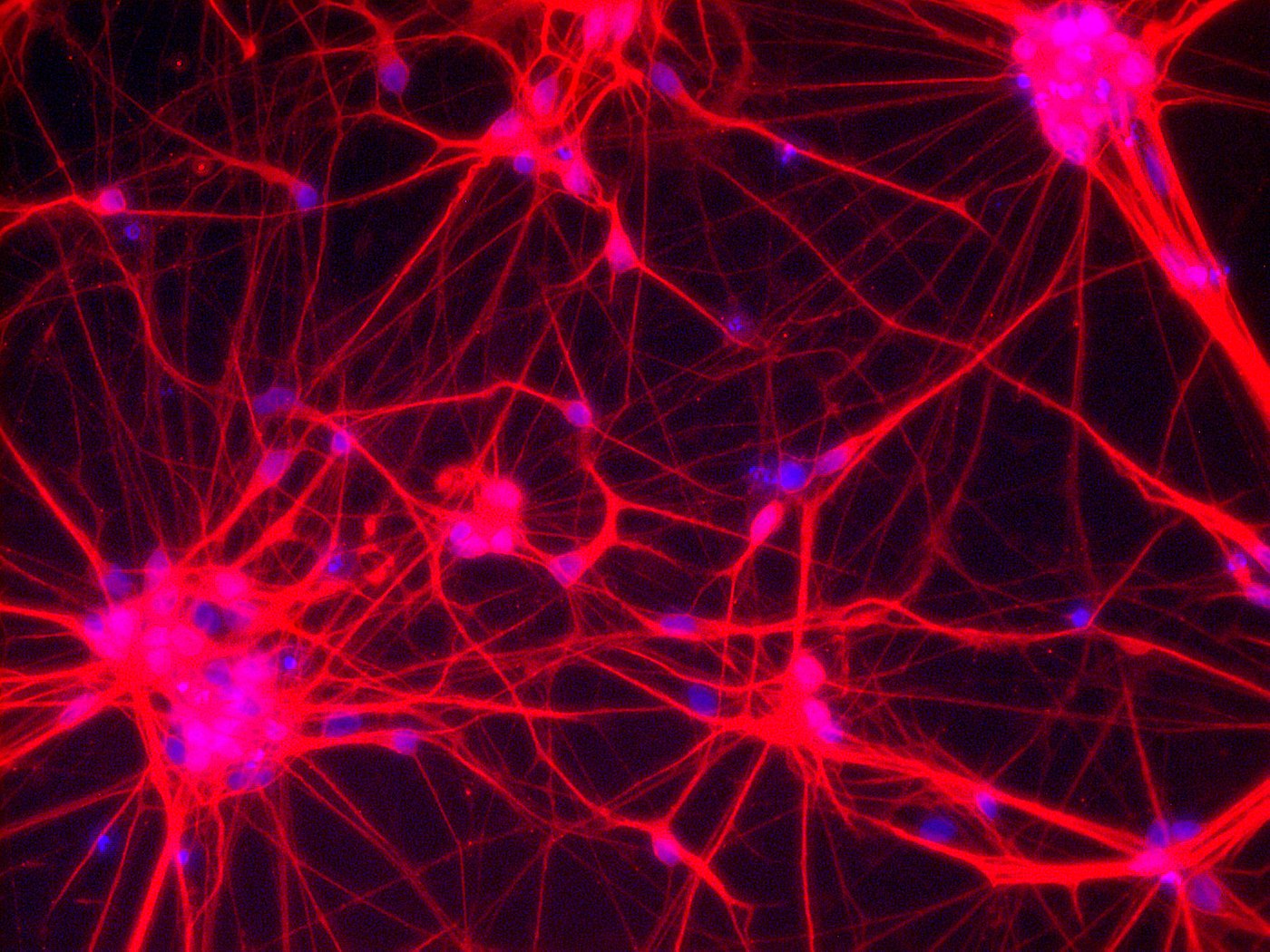
Neurons – Network of neuronal cells (Blue: nucleus; Red: neurons) [Copyright: Institute for Transfusion Medicine, UK Essen]
New methods of genetic modification such as CRISPR Cas9 are opening up possibilities that until recently still seemed utopian. The highly efficient and cost-effective process is one of the most important developments of recent years. Not only research could benefit from this technology, but a wide range of areas of application could also profit. It could give a fresh impetus to both green genetic engineering and animal husbandry, the latter up until now has not played a prominent role in classic genetic engineering. But how does CRISPR Cas9 stand up against the benchmark of current legislation?
Wrestling with the meaning of definitions is what lawyers do. Entire shelves of German legal literature, for instance, have been dedicated to controversial discussions on the question of precisely how active behavior differs from passive omission (failure to act) in terms of criminal law (i.e. act vs omission). It becomes particularly complicated if the legal terms used are referring to a field of research that continues to develop exponentially. In stem cell research, we are dealing with a large number of cases where normative definitions are coming under pressure from new scientific findings. For example, the question arises of whether totipotency still holds up as a criterion for attributing human dignity, given the findings on cell reprogramming. And to cite another example, it is still unclear whether the extraction and use of gametes from induced pluripotent stem cells (iPS) can be subsumed under the definition of German Embryo Protection Act (ESchG).
The development of CRISPR Cas9 as a method of genome editing has recently started another debate of this kind. The background to this debate is whether CRISPR Cas9 and other technologies for genome editing (such as OMD for example) can actually be qualified as genetic engineering under the terms of the German Genetic Engineering Act (GenTG) and the EU Deliberate Release Directive (2001/18/EG). If the decision were to be made that this is not the case, products created using genome editing technology would not fall under the strict deliberate release regime of the Directive, but in future would be treated exactly the same as the results of classic breeding methods. This interpretation of the law would also have an impact on consumer protection. In the European Union, there is a labelling requirement for genetically modified organisms.
The controversy hs flared up - broadly speaking - over the definition in Section 3 Para. 3 of GenTG wherein a genetically modified organism (GMO) is qualified as “an organism [...] in which the genetic material has been altered in a way that does not occur naturally by mating or natural recombination.” Voices critical of the application of GenTG to genome editing (among others, the German Federal Office of Consumer Protection and Food Safety (BVL) in a statement issued on 31 October 2016) argue that when using CRISPR Cas9 it is precisely the fact that no partial sequences of foreign genetic material and vectors are inserted into the DNA that renders the Act inapplicable. Rather, these changes are point mutations which could have occurred naturally. In addition, the question arises of whether there could be any controls at all on technologies whose products do not differ from conventional mutagenesis or naturally occurring mutation. Unlike hitherto standard genetic modification technologies, the vectors used in the CRISPR Cas9 method of genetic modification (guide RNA and the Cas enzyme) are no longer detectable in the end product. As such, the product cannot subsequently be distinguished from naturally occurring variants if it were to be released.
The argument given against removing genome editing from the scope of the Direct Release Directive (and incidentally also from the provisions of the German GenTG which implements it) is that the Directive assesses the classification of a GMO not by the characteristics of the end product but by the process of production. Key here is that “genetic material is directly inserted into an organism that was prepared outside the organism”. Accordingly, for the applicability of the Directive and the associated direct release regime, it is significant simply that the genome of a plant or animal has been changed, regardless of which method was employed to do so. The only things exempt from this ruling are mutagenesis and organisms that were obtained using technologies for genetic modification which have “conventionally been used by a number of applications and have long been considered safe”. None of these exceptions really applies to the new methods of genome editing. Deviating from the process-oriented approach, according to critics, would lead to a far-reaching erosion of the Genetic Engineering Act on account of the expected proliferation of the CRISP Cas9 method and would run counter to the precautionary principle of European environmental law.
In the context of the pending amendment to the Genetic Engineering Act, this issue is likely to continue to be hotly disputed in the coming months. It will crucially depend on whether the regulatory model will gravitate towards the product-oriented approach already introduced in Canada and possibly soon also to be valid in the US or whether it will continue to use a strictly process-oriented approach to classify GMOs. Hitherto, no clarification has been achieved on this issue by the European Union. The statement due to be issued in March 2016 from the European Commission has not been forthcoming. In the event of any doubt, we cannot rule out that this contentious issue will ultimately have to be dealt with by the Court of Justice of the European Union, which is responsible for interpreting European Community Law such as the Direct Release Directive.